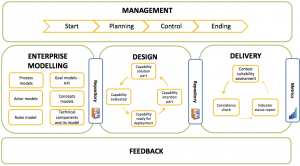CDD lifecycle
CDD has the following core phases – Enterprise Modelling, Design, Delivery and two supporting phases – Management and Feedback.

| Phase/activity | Purpose | Description |
| Management | The capability development and management life-cycle is supported. | The management activity is in charge of taking care of the execution of the project. It includes project planning, performing, control and ending activities. |
| Enterprise Modelling | The input information for capability design is defined. | Capabilities usually serve business objectives and are linked to business strategies. The interrelations between objectives, strategies, structures and processes are captured in enterprise models. Thus, capabilities often are designed on the basis enterprise models. If the company already has some models in place this phase can mostly focus on reviewing and, if needed, refining the existing models. In other cases, if the envisioned capability addresses new business area and/or solutions, then the whole business design might need to be modelled first |
| Design | The capability and applications supporting its delivery are designed. | The capability design explicitly focuses on evaluation of different business service designs in various delivery contexts as capabilities are being customized to specific requirements. |
| Delivery | The capability is put to use. | The delivery phase concerns the actual use of the capability enabled by supporting information systems (i.e., capability delivery environment) with the intention to meet company’s business goals in continuously evolving circumstances |
| Feedback and Reuse of capability designs | The capability improvement cycle is initiated and reusable knowledge is identified. | The feedback activity is used mainly due to the need to take into account additional context factors because not all relevant factors can be identified during the first development iteration. Initially, the run-time adjustment algorithms attempt to modify execution if that is not sufficient, the capability definition is refined, additional context factors are included, as well as capability delivery patterns could be redesigned or new patterns added. The updating cycle is initiated according to the results of capability delivery monitoring and adjustment. These results indicate validity of selected capability delivery patterns and capability delivery patterns are updated accordingly. |